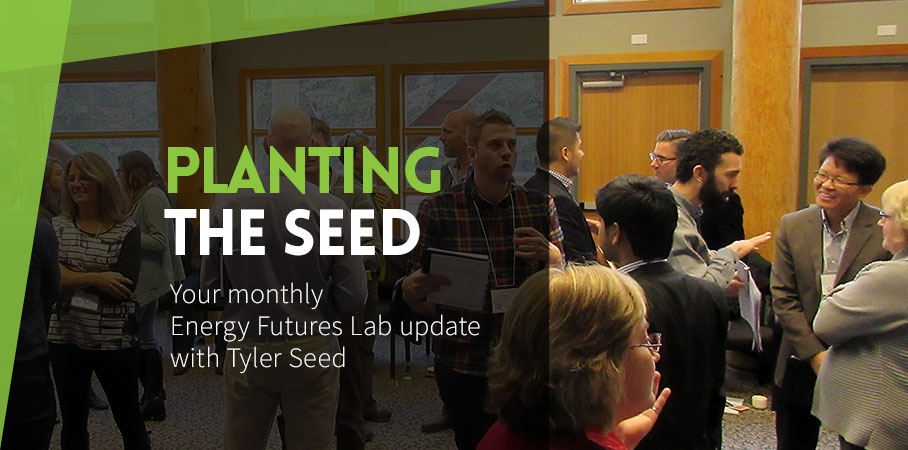
I’m pretty sure that “failing forward” has officially reached buzzword status, and if you’re like me you might be a little tired of hearing about the importance of failing.
That being said, when what we’re trying to do is change massive, complex systems like how energy works in Alberta, it’s not very likely that perfect solutions – whether they be a products, services, or business models – are going to spring fully formed from our heads on the first try.
So what if we could save ourselves some of the heartache and lost opportunity cost of failure by getting as much of that valuable learning done as possible before launch?
3 Reasons to prototype
- It’s cheap – Even if your prototype ends up being very close to the final model you arrive at, or a complete throwaway, it’s not as if you wasted much time, effort, or money. Prototyping allows us to try things with minimal risk.
- It’s going to save you time and money in the long run – We want to do our best to find out what works and what doesn’t before we go too far down any given path.
- Nobody knows everything – Exposing your model to testing and criticism allows you cover your bases and develop your model as much as possible prior to launch.
How to select an idea for testing
The following criteria are proposed by Theory U author Otto Scharmer for the selection of prototypes (Step 3):
Relevance: Does it matter to the stakeholders involved? Select a problem or an opportunity that is relevant individually (for the persons involved).
- Revolution. Could it change the game?
- Rapid. Can you do it quickly (and avoid paralysis by analysis)?
- Rough. Can you do it on a small scale, on the lowest possible resolution that allows for meaningful experimentation?
- Right. Can you see the whole in the microcosm that you focus on?
- Relational. Does it leverage the strengths, competencies and possibilities of the team or network involved?
- Replicable. Can you scale it out (replicate), up (supportive systems), and/or deep (e.g. attitudes, culture)?
Prototyping and Labs
No new tech product or piece of software would get to market without having undergone multiple rounds of redesign to eliminate bugs and optimize user experience, so why should a change initiative?
“A prototype is in fact an experiment, the purpose of which is to determine what works and doesn’t work.” Langdon Morris of InnovationLabs LLC
Prototyping is about testing – rapidly and cheaply – an idea before making big investments, with success defined as the exploration of challenges and possible solutions.
Ideally, prototyping will lead to an idea that deserves further testing, a full-fledged pilot or even a larger “roll out” across the system we’re hoping to change. The only way to fail is to not learn from the experience or not carry forward what has been learned into the next iteration of your solution.
Building and Testing Models
While methods vary, a typical change/innovation lab prototyping process may look something like the following:
- Design Brief – The prototype team drafts a description of the challenge, the types of outcomes they hope to see, and the key features of the response and/or constraints within which they operate.
- Observation and Research – The team spends time exploring the challenge they are trying to address and the systems in which these challenges are embedded. This may be accomplished in any number of ways including research, expert interviews, site visits, etc.
- Ideation and Selection – The team generates ideas that may be worth testing and selects those that will be tested as prototypes. Remember that not all ideas deserve to be prototyped. See How to select an idea for testing.
- Description of prototype – The team articulates a tangible and testable description of the model and prepares for implementation.
- Prepare evaluation plan – The team clearly outlines how it plans to test and evaluate the model during implementation.
- Implement/test and evaluate – Methods of testing and evaluation vary but may include; product testing with key stakeholders, focus grouping, or even Dragon’s Den-style examination by a panel of ‘investors’.
- Decide next steps: According to the results of evaluation, the prototype team may choose to discard the model, apply revisions and continue testing, graduate to a pilot, or go to scale.
Prototyping for a Sustainability Transition Lab
This month the Energy Futures Lab Fellows will convene for the second time. During their first gathering in November, they identified 8 ideas that they wanted to prototype and formed groups to begin the process. At next week’s session, they will take stock of their learnings and identify new ideas for prototyping.
With what is facing Alberta’s energy system today, it’s tempting to want to launch initiatives that seem like no-brainers as fast as possible. If the Fellows share any unifying characteristic it is that they are all extremely action-oriented doers. The facilitators of this session may face a bit of a challenge in harnessing the energy of such a group for the testing and evaluation process.
But the truth is that just about any idea, especially those being launched into extremely complex systems, can be improved and refined through thoughtful and robust (but at the same time quick and inexpensive) testing and revision.
I can’t wait to see what comes out on the other end.

Tyler Seed is a communications professional and writer for the Natural Step Canada. He holds a Master’s degree in Strategic Leadership Towards Sustainability from Blekinge Tekniska Högskola in Sweden.



